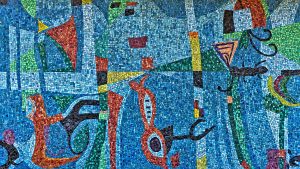Mosaics are created by arranging small pieces of material like glass, tile or paper into a larger picture or pattern. Mosaics have been created by people all around the world for thousands of years. In Chicago, mosaics are commonly seen at train stations and on the outside of public school buildings.
Crescent Moons and Pointed Minarets celebrates the role of shapes and geometry in Islamic art and architecture. Each two-page spread of Hena Khan’s book depicts artistic elements from a different Islamic country.
Speck Lee Tailfeather is a pigeon who wants to share what he’s learned about various famous buildings by traveling around the world. His story, Architecture According to Pigeons, features a section on the Taj Mahal that shows several types of mosaics.
For a more local perspective, Urban Art Chicago has photos of murals, mosaics and sculptures in our city. The book divides artwork based on region and gives information about context and history for each art installation.
Some artists create amazing mosaics with unusual materials. Learn about Kristen Cumings, a mosaic artist who creates using jellybeans in Don't Eat the Art! What unique materials could you use for a mosaic?
Feeling inspired? Create your own mosaic art from paper. Consider using recycled materials, like the side of an empty cereal box for the base and colorful magazine pages or newspaper ads for the tiles.
For a little more of a challenge, try making a seed mosaic using some cardboard, glue and dried beans, grains of rice, popcorn kernels or the shells of sunflower seeds. (It's a good idea to check with a grownup before using food items for your projects.)
Reflect on Your Learning
- Can you think of any examples of mosaics in your neighborhood? What do you like about them?
- Did you try either of the activities? Was it easy or hard to create your design using the small pieces? Do you think that changing the size of the design you filled in would have made the project more or less challenging?




Add a comment to: Marvelous Mosaics: Art for Kids